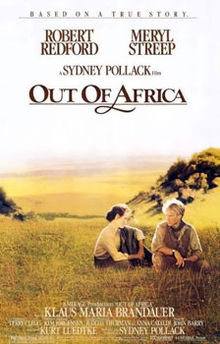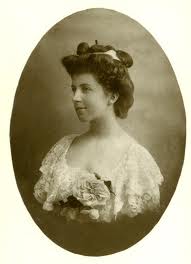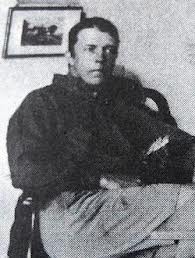 This movie was based on Isak Dinesen’s Out of Africa that was published in 1937. Isak Dinesen is a man’s name, but actually the author is a woman whose real name is Karen Blixen. She used her male and female names for different purposes, and published many books in Danish and English; she was the author of Babette’s Feast, the movie of which won an Academy Award for Best Foreign Language Film. Out of Africa won the Academy Award for Best Picture, but the way this movie was made isn’t perfect; sometimes viewers who have not read the original work cannot understand because there aren’t explanations of the relations between people, and the movie is a bit too long. However, the images of Kenya are wonderful, and I can feel the splendor and charm of the original work, which more than compensates for the short-comings of this movie.
This movie was based on Isak Dinesen’s Out of Africa that was published in 1937. Isak Dinesen is a man’s name, but actually the author is a woman whose real name is Karen Blixen. She used her male and female names for different purposes, and published many books in Danish and English; she was the author of Babette’s Feast, the movie of which won an Academy Award for Best Foreign Language Film. Out of Africa won the Academy Award for Best Picture, but the way this movie was made isn’t perfect; sometimes viewers who have not read the original work cannot understand because there aren’t explanations of the relations between people, and the movie is a bit too long. However, the images of Kenya are wonderful, and I can feel the splendor and charm of the original work, which more than compensates for the short-comings of this movie.
 The original Out of Africa is basically the author’s autobiography. The heroine in the movie (born in 1885) is adventurous, from an affluent family, and unsatisfied with her life in Denmark; she marries the son of a financially struggling baron, exchanging her money for social status, and they embark to the new world of Kenya. In real life, Karen Blixen also married a Swedish aristocrat, Bror von Blixen, in 1913, and they immigrated to Kenya together the following year. Like shown in the movie, the married couple managed a coffee plantation, but the married life soon failed; after the divorce, she continued to manage the coffee plantation alone, but failed, and returned home to Denmark in 1931.
The original Out of Africa is basically the author’s autobiography. The heroine in the movie (born in 1885) is adventurous, from an affluent family, and unsatisfied with her life in Denmark; she marries the son of a financially struggling baron, exchanging her money for social status, and they embark to the new world of Kenya. In real life, Karen Blixen also married a Swedish aristocrat, Bror von Blixen, in 1913, and they immigrated to Kenya together the following year. Like shown in the movie, the married couple managed a coffee plantation, but the married life soon failed; after the divorce, she continued to manage the coffee plantation alone, but failed, and returned home to Denmark in 1931.
 Bror (Baron Blixen), who became Karen’s husband, was born in 1886 as a Swedish noble. He was a distant relative of Karen’s. Bror had an identical twin brother, and the movie establishes that the twin brother was Karen’s lover. The twin died in a plane crash in 1917. Since all the investment for the coffee plantation was from Karen’s parents, when the divorce happened, the plantation became Karen’s property, and Bror started working at a safari hunting company. Many European aristocrats in the beginning of 20th century, backed by economic strength and the success of their nation’s imperialism, seemed to burn with the passion to start their own business; I feel it resembled the spirit of a modern entrepreneur. It is said that many of the clients of Bror’s company were British royalty and aristocrats. After he divorced with Karen, he married explorer Eva Dickson in 1936. Because Eva died in 1938, Bror returned to his home country Sweden, where he died.
Bror (Baron Blixen), who became Karen’s husband, was born in 1886 as a Swedish noble. He was a distant relative of Karen’s. Bror had an identical twin brother, and the movie establishes that the twin brother was Karen’s lover. The twin died in a plane crash in 1917. Since all the investment for the coffee plantation was from Karen’s parents, when the divorce happened, the plantation became Karen’s property, and Bror started working at a safari hunting company. Many European aristocrats in the beginning of 20th century, backed by economic strength and the success of their nation’s imperialism, seemed to burn with the passion to start their own business; I feel it resembled the spirit of a modern entrepreneur. It is said that many of the clients of Bror’s company were British royalty and aristocrats. After he divorced with Karen, he married explorer Eva Dickson in 1936. Because Eva died in 1938, Bror returned to his home country Sweden, where he died.
 After she divorced from Bror, Karen befriended Denys Finch Hatton, the son of an Earl. Denys was born in 1887 into an aristocratic family with a very notable family lineage. When he was 23 years old, he bought land in west Kenya, and started up a safari hunting company on this land with co-investors. He, too, was a noble entrepreneur like Bror, and likewise was a close associate of Berkeley Cole, another noble entrepreneur from a notable family. These four are the key people in this movie. In 1925, after Karen and Bror divorced, Denys became closer with Karen, and started splitting time between Karen’s coffee plantation and the safari company that he founded. Many of the clients for his safari company were also British royalty and aristocrats. All of the characters are young nobles and were played by popular Hollywood actors, but their performances were a little disappointing because they looked somewhat like American cowboys from a Western trying to make a fortune in the gold mines.
After she divorced from Bror, Karen befriended Denys Finch Hatton, the son of an Earl. Denys was born in 1887 into an aristocratic family with a very notable family lineage. When he was 23 years old, he bought land in west Kenya, and started up a safari hunting company on this land with co-investors. He, too, was a noble entrepreneur like Bror, and likewise was a close associate of Berkeley Cole, another noble entrepreneur from a notable family. These four are the key people in this movie. In 1925, after Karen and Bror divorced, Denys became closer with Karen, and started splitting time between Karen’s coffee plantation and the safari company that he founded. Many of the clients for his safari company were also British royalty and aristocrats. All of the characters are young nobles and were played by popular Hollywood actors, but their performances were a little disappointing because they looked somewhat like American cowboys from a Western trying to make a fortune in the gold mines.
In the movie, Karen and Denys’s relationship collapses due to Denys not wanting to marry and because another woman appears; this seems to also be true. From 1930, Denys became close with ranch manager Beryl Markham; the two learned how to fly airplanes, and started to fly around Kenya. In the end, Denys died in a plane accident around the same time that Karen decided to close down her farm and return home to Denmark.
What is wonderful about this movie is that it vividly depicts the pioneering spirit of fearless and carefree youth from the ruling class in Europe in those days. However, the movie also simultaneously successfully depicts an omen drifting in that their privilege will not continue forever. In this movie, these youth disregard their privilege in their homeland and jump over to Africa, and they bravely try their own fate by getting their hands dirty; this suggests that imperialism was still robust at that time. The times shown here may be the last glimmer of European imperialism.
Due to the infidelity of her husband, Karen got syphilis, and she suffered from it for her whole life; in addition, the coffee plantation that she invested everything she owned into failed, but she lived without blaming anyone. The way she lived was wonderful. I feel this spirit in Babette’s Feast as well. The human nature of the author naturally comes out.
Karen observed the subtle differences between the native tribes in Kenya, such as the Kikuyu, Maasai, and Somali. Colonists in Kenya used the Kikuyu for the colonization of Kenya in those days. The Kikuyu were adapted to farming, and the chiefs of the tribes had amicable policies toward white settlers; after having their land snatched away by white people, the Kikuyu stayed there and worked as tenant farmers and maids. Also, the youth became proficient in English because of their education in mission schools. If I use Karen’s words, the Kikuyu are described as, “These natives don’t have rebellious spirits and are patient like sheep. They survived their fates without any political power or a protector. Their ability to accept their fates has allowed them to still endure it.” Unlike with the Kikuyu, the colonists didn’t trust the Somali, who had already been converted into Muslims, and were suspicious that the Somali could rebel at any time. The Maasai had not given up on the hunting lifestyle, so chose to live in isolation. In this movie, it is depicted that even the Kikuyu people fear the strange and unfamiliar Maasai.
It was the Kikuyu that led the Kenyan independence movement because of their understanding of colonists they gained through their experience and by observing them. The Kenyan independence movement had already started with the founding of the East African Association in Nairobi in 1919 by Kikuyu Harry Thuku. In 1924, the Kikuyu Central Association (KCA) was founded with the youth as its core, and they confronted the colonial government and the chiefs who aligned with it; the radical movement of the KCA developed into the 1952 Mau Mau Uprising, and with this, white settlers began to evacuate. The nationalist/independence movement converged into becoming the Kenya African National Union, and Kenyan independence was achieved in 1963.
